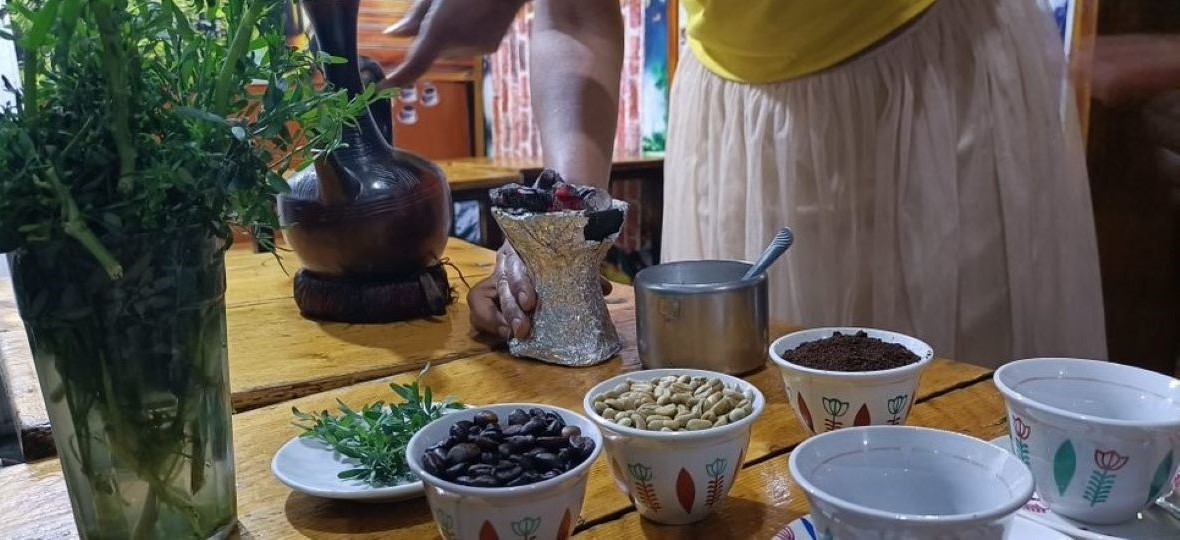Addis Ababa has a bold cosmopolitan vibe, the Dubai-like cityscape changing almost daily with the addition of new skyscrapers. The Ethiopian capital also boasts a rich cultural mosaic, together demanding more than just a stopover. And when doing so, what better way to discover the East African country’s exotic culture than through its food?
Ethiopians have long combined exotic spices from the Far East with their own indigenous grains – creating a cuisine that is distinctly and indisputably their own. Dishes are earthy, tart, pungent, and sour, with ever-present spicy flavours in dishes like Tibs (beef stir-fry), Doro Wat (chicken stew), and Kifto (beef tartare), made from a base of the famous spice blend known as Berbere or Mitmita.
Following Ethiopian traditions, there are many dishes that are wholly vegan. There’s Shiro, a delicious stew whose primary ingredient is powdered chickpeas or broad beans combined with special herbs and spices; Miser Wat, a kind of spicey red lentil dish; Kik Alicha, a split pea stew; Gomen, an Ethiopian styled collard greens; Karat Alicha, a potato and carrot-based stew; and then there’s Beyaynetu, a vegetarian dish that includes them all.
The variety of flavours and textures displays the true potential of vegetables; and considering the historical significance of vegetarian eating in Ethiopian culture, it’s no surprise that it’s everyone’s favourite.
Like most Ethiopian dishes, Beyaynetu is served with the gluten-free teff flour bread known as Injera (a large pancake with a sourdough taste). Injera has a spongy consistency, perfect for soaking up the sauces of thick stews. In the case of Beyaynetu, injera is not only the staple food, but the plate and cutlery as well, as it’s served underneath stews and used as a scoop.
Ethiopians usually wash their hands in a basin with water poured from a metal or earthenware jug before eating. They then say a prayer of thanks, patiently wait until an elder takes the first bite, then dive in. Here you eat with the right hand (the left is considered unclean).
Beyaynetu banquet
The time-honoured Beyaynetu is a colourful communal affair, and eaten off a central plate (gebeta), which is brought to the table covered with a large flat piece of injera. More injera is brought to the table in a brightly coloured wicker basket (mesob). With Beyaynetu prepared, the host – in our case, the Tadesse Grand Bar & Restaurant – places several heaps of each vegetable stew on the central plate, which is prelined with a large injera underneath the vegetables, collecting the juices. If Wot (spicy meat/fish stews) is being served, these will be placed towards the centre, making it a Yetsom Beyaynetu. The aroma hovering over the plate is mouthwatering.
Start by tearing off a piece of the injera that’s on central plate then, using it as a grabbing tool, scoop up pieces of fish or spiced vegetables (thus collecting the sauce), and pop it in your mouth. This is central heating for the soul, you’re eating the essence of Ethiopia.
In Ethiopia, it is traditional to eat injera at least once a day.
“The basic spice mix is Berbere,” says my food guide, Mulugeta. “It’s sprinkled on everything. Every household has their own variation. But it’s mostly chili peppers, dried garlic, ginger, cloves, fennel seeds, Ethiopian cardamom, nutmeg, and cumin – in total about 15 different spices. It’s cooked for hours just to get rid of the heat and intensify the flavour (with added sautéed onions) which turns into a paste called Dilik.”
I enquired after injera. “It’s the staple of our cuisine. It is to us what a tortilla is to Mexican food, or rice to Asian cuisine, and is made with nutrient packed, gluten-free teff grain. It’s our superfood.”
Injera
The making of injera is intricate. It needs teff flour, water, and a seed culture, ersho. These are mixed by hand to make a creamy dough that is left to ferment for three days (which is where the tang comes from) in a metal or wooden container (bohaka).
Once the primary fermentation is complete, a small part of the dough is diluted to a paste with water, then boiled. The cooking process gelatinizes the starch and makes the absit. After its preparation, the absit is mixed back into the primary fermented batter, which is left to ferment for two hours. The absit produces gas and makes the dough rise.
The dough is cooked by pouring it onto a large, heated plate, then covered with a lid. In just a few minutes a large, bubbly surfaced, spongy crepe is produced.

A fish alternative
For a plate heaped high with whole fried Tilapia fish, we headed to Genesis Fish House, a restaurant considered one of the city’s best food destinations. The fresh-water fish is washed with water and cardamom, scored, covered in wheat flour, then deep fried till super crunchy. It’s served with a spicy side dipping sauce of chilli, garlic and ginger. The preparation of scoring the fish makes it easier to pull pieces off when eating; without having to deal with bones.
Religion and food
Given that most of the population are Orthodox Christians, many Ethiopians follow the fasting days that the church directs. There are 250 fasting days a year; but only 180 of them are obligatory. The Orthodox Christian community in Ethiopia follows a weekly fasting schedule prescribed by the church – Monday, Wednesday, and Friday, along with the 55-day Lenten fast and other holidays.
“Fasting doesn’t mean refraining from all food,” says Mulugeta. “Instead, we don’t eat or drink until 3 p.m. on those days and eliminate all animal products from our diet. Basically, we adhere to a vegan diet during fasting days – which is why you can find a wealth of vegan and vegetarian options across Ethiopia. From Shiro be Kibbe to Miser Wot, you’ll have your pick. But, if you want a taste of all the plant-based foods that Ethiopian cuisine has to offer, the Beyaynetu is one of the most popular.”
Now for the meat
With this curiosity satisfied we continue on to sample Awaze Tibs at the Black Lion Bar & Restaurant. Awaze is a spicy simmering sauce, another staple of Ethiopian cooking, and Tibs are strips of sirloin steak.
A mound of succulent steak strips arrived on a round of injera, flanked by a kaleidoscope of side dishes – roasted eggplant in berbere sauce, stewed lentils, split peas, Dinish (a spiced carrot, potato and cabbage stew), green beans, sautéed collard greens, and one of the most delicious garlic-tofu spreads I’ve ever tasted.
The chef slow fry’s strips of sirloin steak in Tesmi (spiced butter), which is served with a kick-in-the-pants Awaze chilli paste that transforms any meal into a culinary experience. It’s an especially saucy dish, making it all the better for mopping up with injera.
Following gentle persuasion, the preparer divulged his Awaze recipe: oven roast mustard seeds, hot chilli powder, long peppers, Ethiopian basil, black cardamom, and caraway seeds, then blitz. To make a smooth paste add garlic, fresh ginger, and a little bit of oil, then blitz again.
I enquired as to why Ethiopians love spicy food. “Maybe it’s the endorphins that are released that give us that feel-good sensation. Or it could be the delight of pushing our taste buds to the max. But it also does wonders for our health. But who need health benefits to defend our love of spice?”
A shot of caffeine
It is unfeasible to disconnect Ethiopian culture from coffee. They undisputedly grow the world’s finest Arabica bean which, they claim, was discovered by a 6th century goat herder who watched his goats become extremely energetic after consuming (what turned out to be) Arabic coffee beans.
At Tiru’s, a tiny buna (coffee shop), we partake in a Habesha coffee ceremony – a practice fundamental to the fabric of Ethiopian society.
“It’s a core cultural custom in Ethiopia and begins with loosely spreading grass on the floor where the coffee ceremony is held,” Mulugeta warms to the subject. “The coffee is brewed by first roasting the green coffee beans over an open flame in a pan. This is followed by the grinding of the beans, traditionally in a wooden mortar and pestle. The coffee grounds are then put into a boiling pot (jebena) and left on an open flame for a couple of minutes – until the coffee and water have got to know each other. It’s sieved then boiled twice more.”
At our second coffee stop, a lean-to beside the Bank of Abyssinia on Gabon Avenue, our hostess, Shelema Hirpho, pours the coffee by moving the jebena over a tray of small porcelain cups, from a height of one foot, thus aerating the brew.
“The coffee ceremony always includes the burning of some kind of traditional incense,” says Shelema, “I use Gum Tree bark, which I add to the coals that brews the coffee. It’s burning incense is heady, and the very morish. But beware, this is fully loaded, high octane Arabic coffee beans, they are not to be trifled with.”
There is only one true way to get to know a country and that’s to go there and to eat and drink the amongst the people who consume it every day. That way its seasoned with a sense of the place, the landscape, the culture, and the traditions.
https://www.gofurther.tours/trips/taste-of-ethiopia/
If you enjoyed or found this story useful, we’d appreciate if you would forward it to a colleague or friend who may also enjoy it. If, on the other hand, a friend shared it with you, welcome! You can get all the latest travel news and reviews from Travel Industry by simply clicking HERE.

